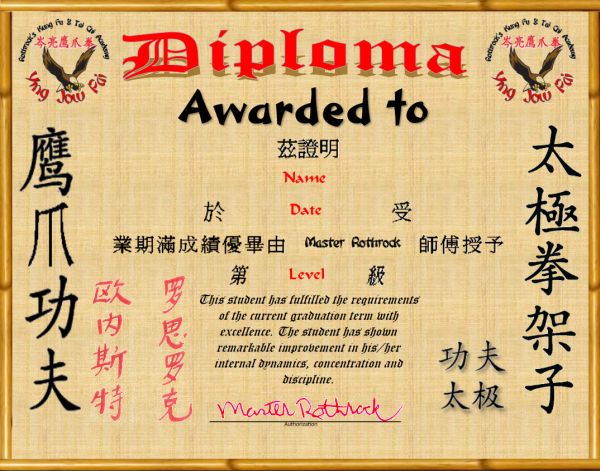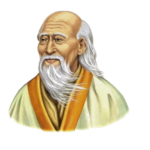Monthly Newsletter
My Promise to You! You will love every minute of your experience at the Academy. My friendly and professional staff will keep you motivated and work with you one-on-one so you never feel out of place or uncomfortable.
Table of Contents
Master's Notepad
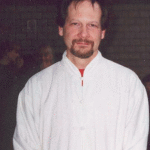
e are moving into Spring and warmer weather. April is an ideal time for spring cleaning, traveling, and kicking off those family cookouts.
In April, we have a great special for new members. Try a free, no-obligation Class and receive a complimentary Start Kit, which includes a brochure, newsletter, and DVD. Please share this with your friends or relatives who may be interested in trying a few classes.
Click Here for the Special - https://www.rothrockskungfu.com/trial/
This month's merchandise special: Buy 2 shirts and save 15%. We only offer this special in the springtime, so get some extra pants today.
This month’s article explores the concept of doing something a thousand times. We have a saying: To practice for 1,000 days is said to be discipline; to practice for ten thousand days is refinement. In other words, regardless of what you are trying to excel at, you must practice discipline for an extended period. That is a great lesson, especially for children.
This month's animal is the Leopard. The Leopard is fast, crafty, and outsmarts its opponent. You can read more below. The self-defense technique of the month is called Pin Leopard. That is for a bear hug from behind, and you’ll use the leopard techniques for defense.
All the basics for the adult and children classes have been updated to incorporate more techniques associated with this month’s animal. This will help you learn and understand the methods for each animal better.
This month, a unique Master Club class is available on the Spinning Saber. The Spinning Saber teaches you the basics of the saber and develops strong wrists and forearms. The Chief Instructors determine which days they teach these special, master-level classes. So, don’t miss out!
“Always do your best. What you plant now, you will harvest later.”
"Success isn't about being the best. It's about always getting better.”
Keep Training,
Master Rothrock
Kid's Corner
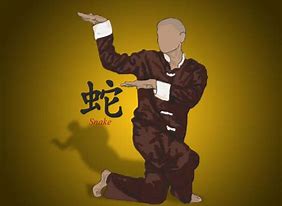
Animal of the Month - The Leopard (Pao)
Leopard (Pao) Kung fu is a style of Chinese martial arts and one of the Five Animal styles. Jue Yuan supposedly created it with help from Bai Yufeng and Li Sou. The leopard's emphasis is on speed and angular attack. Unlike the tiger, the leopard does not overwhelm or rely on strength but instead on speed and outsmarting its opponent. The power of the style derives from its aggressive speed. The leopard practitioner will focus on elbows, knees, low kicks, and leopard punches. Leopard kung fu is a hit-and-run style designed to overcome superior forces with inferior resources. Counterattacks are sudden, indirect, and short, with the aim of landing a debilitating technique. The Leopard develops patience. Movements developed speed and strength and were executed fast, shifty, and crafty with narrow stances and clenched fists.
The Theory of a 1000

Learning basics. That is one of the most important aspects of Kung Fu training. We could perform our self-defense, forms, sparring, and weapons routines with proper guidance and repetition of the basic techniques. Typically, after the first couple of months, most individuals find basic training drills to be tedious. After that, they feel confident in their abilities. But see what happens when they do combination techniques such as Block, Kick, and Punch. Often, I have to correct students on the basic drilling fist punch while they are practicing self-defense or a form. Why?
The answer is simple: more practice is needed. How often have I said, "Do this 1000 times, and you'll become good." Many students look at me as if I'm joking. I'm not. In fact, the number 1000, in Chinese thought, represents an infinite number that transcends human comprehension. Now, that's a lot of practice! This advice is applicable to all levels, from white to black. Even after 55 years of practice, when trouble arises in a series of techniques, I break them down to their basics and practice each one individually before returning to the whole set.
Continued repetition is necessary because of all the parts of a particular technique. For example, let's list some of the details of the corkscrew punch: proper fist, held at the waist correctly, touch the side of the body while punching, a full twist after the elbow clears the front of the body, hit with the front two knuckles only, in line with the center of the body, full-extension, shoulder relaxed, hips forward, snap power at the end, chest level, wrist straight, and coordinate all of this with the other hand. As you can see, numerous things could go wrong.
Progress is made in various levels of achievement and basic techniques. Many advanced students can testify that basic training seems more challenging as we improve our techniques' speed, power, timing, and coordination. Also, we must start to understand the relaxation and tension involved in the basic technique. The body must remain relaxed as we execute the technique, become tense only at the very last instant before the end of the technique, and relax immediately after completion. Sounds easy. Let's compound that by adding that tensing the muscles does not mean in the entire body. Only the muscles necessary for developing the proper power in the technique are used. A drilling fist punch does not use the same muscles as a knife-hand strike.
Power penetration refers to the ability to penetrate power into an object, not just its surface. We start our training in this area by first hitting the bags. Whether using our hands or legs, we must learn to maintain proper distance from the target. Too close, and we push; too far, and we overextend. Next, use a partner holding a bag against their body and see if they can feel the power on the other side. If they did, you are starting to develop power penetration. Remember, we must now learn control. Whether we are practicing a single basic technique or a series, these guidelines must be followed: hitting an object or not, engaging in self-defense, performing a form, or practicing with weapons. How can you accomplish all this? Practice 1000 times, and you will develop unbelievable skills.
Joint Flexibility
Joint flexibility keeps your joints healthy and loose. Inflexible joints can lead to arthritis, nerve damage, stiffness, and joint damage. Healthy joints require rotation, flexibility, and strength.
The full-range circular moves +of Kung Fu and Tai Chi rotate the joints as you build strength and improve your flexibility. That keeps your joints healthy and increases blood flow.
Since everything on your body is circular, circular movements are the best way to keep your body healthy. Plus, this is the way your body moves naturally. Therefore, straight and linear actions are less beneficial for your body.
As I mentioned, the Yin/Yang has two components: light and dark, strong and flexible. Therefore, a healthy body requires that you keep these two opposites in harmony.
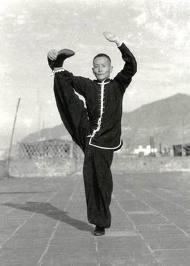
The Sensing Hands of Tai Chi
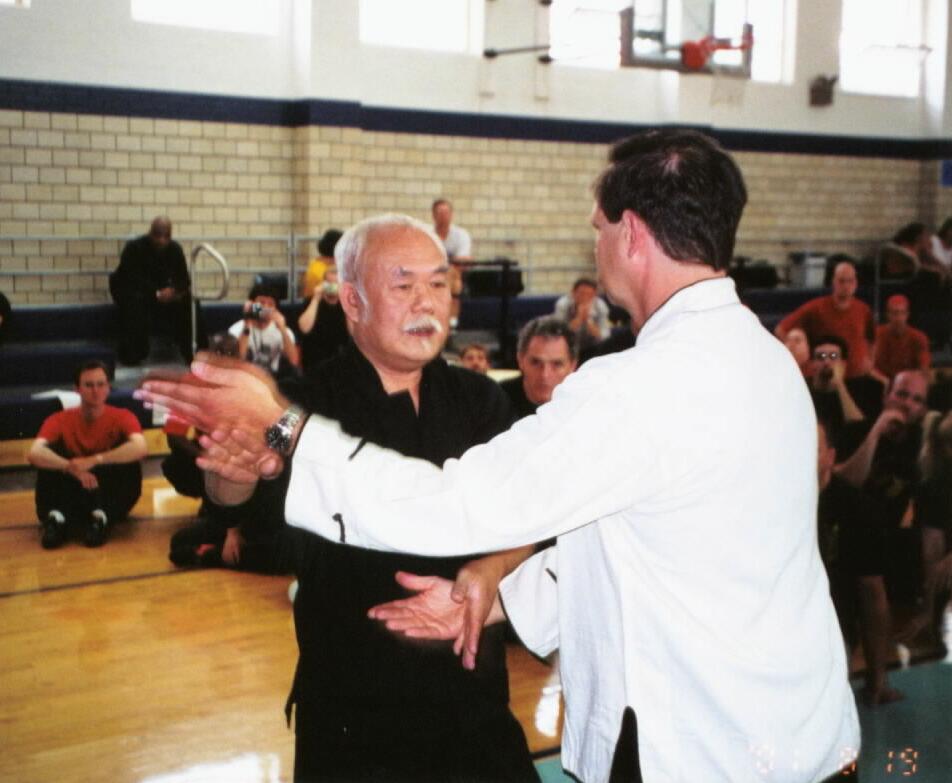
Sensing Hands (Pushing Hands) teaches a Tai Chi student how to use Tai Chi for protection. If you’re unfamiliar with Tai Chi, it is a slow-motion, low-impact exercise and self-defense system. The words Tai Chi Chuan mean Grand Ultimate Fist. The Chinese consider Tai Chi the best method for self-defense and health, which is why it is named as such.
Tai Chi is never offensive but defensive. In fact, it only works when you are attacked. The basic principle of Tai Chi is that you never stop a force or an aggressor coming at you but guide the force away from you. Then, you use the opponent’s unbalanced position to uproot and dissolve their attack.
Sensing Hands, a method used in Tai Chi to teach the basics of self-defense teaches you to feel the force coming at you while maintaining your balance against your opponent. You do not try to stop the force but rather guide it away from you. You evade, avoiding the opponent's power and strength. You then use the opponent's unbalanced position to find a point to gently push them further off balance. The entire exercise involves staying relaxed and rooted with a calm mind.
Welcome New Members
Lucas Gomez
Lennon Stutzman
Prasanth Prabhakaran
Alejandro Pazos
Michael Waligora
Debbie Neely
Sarah Maynard-Murry
Janet Sapet
Chiara Signorelli
Jane Maynard-Murry
Piper Maynard-Murry
Vishaka Bharath
Kathy Vactor
Stephanie Stepanow
Alexandra Pappas
Arlene Smith
Dave Smith
Becky Pedersen
Rhys Ireland
Lucas Palladino
Sandy McKnight
Kaden Sturges
Troy Jindra
Stanley Grubjeric
Leslie Green Guilbault
Stephanie Hawkins
Linda Gagliardo
Matthew Yarbough-Hoskey
Nate Rossman
Cynthia Vale
Siobahn Rossman
Robert Rivera
Adam Henger
Andrea Noyes
George Klayko
Copyright © Rothrock's Kung Fu & Tai Chi. All Rights Reserved
